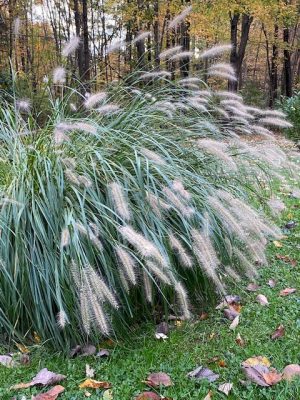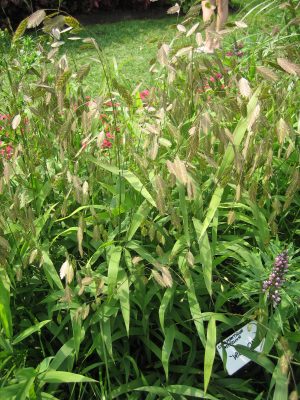By Dawn Pettinelli, UConn Home & Garden Education Center
Autumn shines a spotlight on ornamental grasses. With their rustling blades and fluffy seedheads they are star performers in late season gardens going head-to-head with asters, mums, Montauk daisies and boltonias. Plus, they are great in fresh or dried cut flower arrangements.
The huge selection of grass species available is great for gardens but makes selecting difficult. Heights range from a few inches to more than 6 feet; colors from deep green to chartreuse, burgundy to black. Solid or variegated? Would a clump former, spreader, or self-seeder best fit your needs? Are seed heads important for fall and winter interest? Is this grass planted as an ornamental feature in your garden bed or landscape or are you looking for natives to support pollinators and perhaps serve as food for birds and others? Answers to these questions may guide you in grass selection.
Two favorite non-natives grown for their ornamental value are cultivars of Miscanthus and Pennisetum. While the miscanthus species has been listed as potentially invasive in CT, a number of attractive cultivars are available for purchase and can be striking if well positioned in the garden. Two outstanding selections are ‘Gracillimus’ and ‘Zebrinus’. The first has shimmering silver veined green leaves growing in graceful mounds. Reddish flower plumes emerge in fall changing to a light silvery hue. Plants are clump formers but can reach 6 feet or more in height.
‘Zebrinus’ is more commonly known as zebra grass for its definitive yellow and dark green striped foliage. This plant gets big over time. Mine is now 6 feet across and probably 10 feet high. I wrap a rope around it in the late summer to keep it upright through fall rains and winds. Stalks have been used quite effectively as a substitute for cornstalks around the lamppost.

My Pennisetum alopecuroides was grown from seed probably 20 years ago. These plants are absolutely gorgeous in the fall. Despite the many bottlebrush seed heads, I’ve never found a seedling. The fine, arching foliage resemble flowing water hence the common name, fountain grass. Cultivars of this graceful, flowing grass range from 18 inch ‘Piglet’ to 5 foot ‘Fox Trot’.
Native grasses are soaring in popularity and much easier to find at garden centers than they used to be. One switchgrass (Panicum virgatum) cultivar, ‘Heavy Metal’, is quite popular for its upright, striking blue-green foliage. If happy, it can reach 4 to 5 feet in height. The wheat-colored seed plumes are attractive to us during the gloomy winter months but also as a food source to a number of bird species.
Little bluestem (Schizachyrium scoparium) is a favorite also of humans and wildlife, including both birds and butterflies. This upright native grass is pretty ubiquitous along roadsides and in fields and meadows. New growth begins a clean blue green but, by the end of the growing season shifts to deep bronze and chestnut hues. This is a tough plant content in sandy soils and reaching about 2 feet in height. The silvery seed tuffs are retained for most of the winter. Little bluestem combines well with a number of perennial wildlings like rudbeckia, pearly everlasting, goldenrod and species of asters.

Also commonly found along roadsides, purple lovegrass (Eragrostis spectabilis) grows on sites from full sun to part shade. This is a very well-behaved grass in the Poa (bluegrass) family. It is native to eastern and central U.S. and produces those airy pink seedheads you might admire as you drive.
Northern sea oats (Chasmanthium latifolium) has very distinctive, but attractive seedheads. Native to the eastern and southern parts of the U.S., it is hardy from zone 5 to 8. Northern sea oats is a clump former with showy panicles of flowers in late summer that mature into wide, drooping seedheads. This grass likes moist but well-drained soils and is a larval plant for several species of butterflies as well as serving as a food source for several mammal and bird species.
Other native grasses worth investigating include side oats grama (Bouteloua curtipendula), big bluestem (Andropogon geradii) and prairie dropseed (Sporabolus heterolepsis). Check out both native and exotic ornamental grass offerings for their varied textures, colors, forms and flowers.
For more information on growing ornamental grasses or selection or for other gardening questions, contact the UCONN Home & Garden Education Center, toll-free, at (877) 486-6271, visit their web site at www.homegarden.cahnr.uconn.edu or contact your local Cooperative Extension Center.